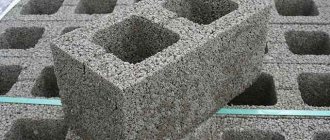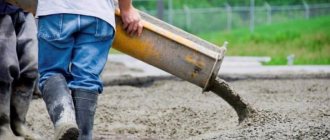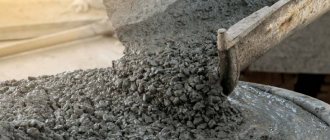Every novice builder is faced with such a concept as cement laitance (CM). This name sounds quite harmless, but many experts strongly recommend removing the mass that has formed on the concrete surface. On the other hand, there are a lot of recommendations according to which CM allows improving the characteristics of not only concrete, but also crushed stone, as well as expanded clay. Let's understand all the intricacies of using this liquid.
Why do you need to remove cement laitance?
First of all, you need to understand what cement laitance is.
To pour concrete, a solution is prepared from Portland cement, sand and water. If all components are selected in the correct proportion and were mixed until a homogeneous mass is obtained, then the composition is considered optimal. However, quite often the mixtures are prepared too dry, which is why the concrete mass begins to delaminate during laying and vibration compaction. Heavier components displace water and cement outward, and a dirty white suspension is formed on the surface, which is called a cement film or milk.
Healthy! Sometimes CM is formed as a result of chemical reactions occurring in the concrete mass (under the influence of alkali metals). In addition, ash and other wastes are often added to concrete, which also lead to the formation of a milky film.
Most often, the appearance of CM is an undesirable effect, since such a film has very low strength characteristics and a glossy texture. Because of this, the adhesion of the top layer of the concrete surface is reduced. If you paint such a screed, then after a few years the finishing layer will begin to fall off. This happens because the CM prevents the paint from penetrating the sand-cement mass.
That is why during the concreting process it is important to remove cement laitance even before the screed has completely set.
Types of polystyrene concrete screeds
I can distinguish two main types of polystyrene concrete screeds - thermal insulation and structural-thermal insulation. In the first case, mixtures with lower density and lower thermal conductivity are used. They are very effective as insulation, but at the same time withstand less load.
For screeds, it is better to abandon this option. In the second case, a denser mixture of up to 600 kg per cubic meter will be required, which will withstand higher loads. I consider the optimal density for arranging screeds to be 400 kg per cubic meter. Such a screed with high strength characteristics will provide excellent thermal insulation and sound insulation.
Strength or thermal insulation properties?
.
How to remove CM
To do this, you can use one of the methods for removing unwanted film:
- Mechanical. In this case, the film formed on the surface is removed using shot or sandblasting machines. This technology is considered expensive and very labor-intensive. In addition, it is difficult to remove milk from hard-to-reach places using machines. In this case, it is most convenient and cheaper to use water-air equipment. Also, mechanical cleaning can be done using ordinary metal brushes, but this will take a lot of time.
- Chemical. In this case, special acid solutions based on hydrochloric or acetic acid are used to remove CM, which allow you to get rid of unwanted plaque in the shortest possible time. However, it is worth considering that such compositions not only dissolve the film, but also negatively affect the concrete itself. This method is used extremely rarely.
Healthy! When chemically removing a film with a solution of hydrochloric acid, it is necessary to neutralize the composition using concentrated alkali. After applying the solution, the surface is thoroughly washed.
Despite all the disadvantages of CM, such compositions are quite often used for certain types of work.
How to make a floor screed with expanded clay: a review of 3 options
Expanded clay is a well-known material with remarkable consumer properties. It is widely used in construction and repair: for insulating walls and foundations, as inexpensive sound insulation, and also in the manufacture of a rough base for finishing flooring. Let's figure out what it is, how a floor screed with expanded clay is laid and how complex the technology is.
All about floor screed
Material properties
It is made from special types of clay, which are dried, crushed, cleaned of impurities, and then molded into granules. As a result of high-temperature treatment, they acquire porosity and extraordinary lightness. Thus, the technical characteristics of the material are determined by the properties of natural raw materials, as well as the characteristics of the manufacturing process.
Given its ability to retain heat well, expanded clay backfill is often used as insulation for roofing and interior partitions. Its thermal conductivity ranges from 0.07-0.16 W/m*C: slightly worse than that of mineral wool and expanded polystyrene (penoplex), but better than that of brick and reinforced concrete. In addition, expanded clay is cheaper than traditional thermal insulators, which makes it even more attractive for developers.
Burnt clay granules have high strength and therefore are able to withstand significant loads, but in bulk form they have a non-solid structure. To use them as a finishing layer, they must be additionally compacted with something.
Good sound absorption allows the use of such backfill as a means of noise suppression. This property is in great demand in individual construction, as well as when renovating apartments. It is not surprising that ceramic stones are often used for soundproofing homes.
Despite their natural origin, they do not rot and are not of interest to rodents. In addition, the material does not support combustion and does not emit toxic substances when exposed to an open flame.
Pros and cons of floor screed with expanded clay
pros
Using this technology, you can level out any unevenness and distortions of the base, raising the floor level to the desired height. Perhaps this is the main advantage of using granules. After all, pouring a thick layer of concrete is too expensive and difficult. And in some cases it is even dangerous: in very old houses, the floors may not withstand the weight of hardened cement reinforced with reinforcement.
This subfloor is resistant to temperature changes and the difference between temperatures inside and outside the room. This matters for foundations on the first floors: it is always colder under the floor than above. Moreover, both in private buildings and in city apartments.
The coating made of clay granules allows air to pass through, which allows you to create a healthy microclimate in the living room, which is especially useful for those who have problems with the breathing apparatus. Of course, concrete also has air permeability, but to a noticeably lesser extent. Forming a base that includes a light ceramic backfill is easier than a regular concrete one, so you can do it yourself without involving specialists. And, best of all, it will cost less.
Minuses
A subfloor with expanded clay in concrete cannot be small in thickness, at least 10 cm, and in some cases 15. Some will be pleased with this fact - additional insulation will not hurt. But if the apartment has low ceilings, then such a high floor with a finishing layer will noticeably hide the living space
Application of CM in construction
Depending on the type of base, the milk is used for:
- sealing small cracks in the base;
- pouring expanded clay when installing a heat-insulating layer of screed;
- ironing of bases;
- strengthening the underlying layers (sand and cement) during the construction of foundations;
- repair of old concrete (sealing cracks and chips);
- processing of metal containers (thanks to CM, corrosion protection increases);
- leveling surfaces.
Depending on the scope of use of the solution, the milk is prepared in different proportions.
Practical advice
To increase the strength of the expanded clay screed, it is recommended to moisten it with water twice a day. This must be done carefully, do not fill it with water, and do not let the dry expanded clay get wet. Watering significantly improves the physical performance of the screed; the chemical reactions of the cement mortar proceed in a favorable manner. It takes two to three days to water the screed; the exact time depends on the weather. At high temperatures, the number of soakings increases; the top layer of the screed should not be allowed to dry completely.
Wetting the screed with ordinary water is necessary to ensure that the floor is level.
If the operating conditions of the building require an increased height of the expanded clay insulating layer, then it can be laid in bags. Plastic bags increase the stability of the position of the granules, expanded clay does not crumble under the feet of the master, and there is no need to use special additional devices and devices. To completely level the surface of the filling, a layer of small fractions 2–3 cm thick is added on top. This technology allows reducing time by 30%.
Expanded clay in bags
If possible, do not use expanded clay floor insulation technologies using cement laitance. The strength of the base will increase, but the heat saving effect will significantly decrease. There are many other construction techniques to increase the load-bearing capacity without reducing the thermal protection of the floor.
Expanded clay is shed with cement laitance
Expanded clay insulation is very profitable to do in outbuildings or garages. Especially if the construction site is uneven, and it is impossible to carry out excavation preparatory work for various reasons. Expanded clay will independently level differences in the base height up to ten centimeters; an increase in the amount of material does not have a noticeable effect on the change in the initial estimated cost of the object.
How to prepare CM
Compositions of this type are not controlled by building codes, since it all depends on the specific situation. Therefore, there are several recipes for preparing such a mixture:
- To seal cracks, a solution of water and cement is prepared in a ratio of 2:1.
- When strengthening the screed, the proportion of cement should be up to 30% of the total mass.
- When laying the underlying layer under the foundation, the components are mixed in equal parts.
- To impregnate expanded clay with cement mortar, it is recommended to prepare a more liquid solution - add 2-3 parts of water to 1 part of PC.
- When finishing interior or exterior walls, you need to mix 3 parts of cement and 1 part of water.
Thus, CM can be in the form of a suspension, liquid dough or suspension. Based on this, the composition is rubbed into the concrete during the process of hardening or poured onto the aggregate (for example, an expanded clay layer). If laying will be done manually, then it is more convenient to prepare a thicker mass from PC and water (3:1). If you plan to use a special grater or lath, then it is better to reduce the amount of cement to 1.5 shares.
Before preparing the solution, it is necessary to sift the Portland cement so that there are no lumps or debris left in it. To ensure that there are no clots in the finished milk, it is recommended to use a drill with a mixer attachment to mix the components. To increase the plasticity of the CM solution and achieve a lighter shade of the solution, it is recommended to add slaked lime to it.
If, when laying and filling a layer of expanded clay with cement-sand mortar, the CM is not poured, then the smallest granules of the material will begin to rise to the top, and the heavier ones will sink down. This will significantly affect the strength and density of the entire structure. To prevent such delamination, the expanded clay must be soaked in milk so that each granule is covered with a liquid solution. This will lead to gluing of the material, which will be a homogeneous, durable mass.
The consumption of CM in this case will depend on the thickness of the layer.
Advantages of expanded clay
The history of expanded clay goes back to the distant Middle Ages. Today it is one of the most affordable building materials. Expanded clay is produced by burning clay shale in special kilns. Since the resulting material consists of 95% clay, it has all its positive qualities:
- Environmental friendliness. This property of the material allows it to be used in any residential premises.
- Resistance to mechanical stress.
- Resistance to corrosion and rotting.
- Non-flammability. Clay is chemically inactive, and all slags and third-party components burn out during the firing process, so the final material is not subject to combustion.
- Excellent sound insulation and thermal insulation. The presence of pores in the granules explains the high noise absorption and thermal insulation properties of expanded clay.
- Resistance to chemical agents.
- Durability. Clay practically does not wear out either under the influence of high temperatures or cold. In the open air, expanded clay can last up to 300 years without any visible destruction of the structure.
- Resistance to low temperatures.
- Strength. According to this indicator, expanded clay is not inferior to sand-lime brick. The relative lightness of the granules does not affect the strength in any way, since clay particles inside the granules under the influence of high temperatures create stiffening ribs.
- Relative lightness of the material.
- Low cost.
Consumption and cost of cement laitance
Since in nature there are no GOST standards regulating the ratio of components and consistency of milk, its consumption per 1 m2 will differ depending on the purpose of using the composition. However, processing expanded clay usually requires a little more composition than when ironing concrete.
In turn, the cost of the solution also directly depends on the ratio of components in the CM:
- If the composition contains 1 part of cement and 3 parts of water, then it will cost about 2,800 rubles per 1 m3.
- If the ratio of cement and water is 1:2, you will have to pay about 3,000 rubles.
- If 1 part of PC requires 1.5 parts of water, then such a solution will cost about 3,500 rubles.
- With an equal ratio of components, you will have to pay 4,500 rubles per cube of milk.
- If the volume of cement is 2 times the water content, then the price of the mixture increases to 5,500 rubles.
Of course, it is much more profitable to make the solution yourself.
Peculiarities
Cement laitance most closely resembles gray water. This is a liquid that is released from cement after completion of pouring work and negatively affects the technical characteristics and further processing of concrete. The milk must be removed before finishing work begins, since otherwise the finishing layer will last a maximum of a year or two.
In other situations, cement laitance is beneficial. Thus, when making roofs/attic floors or creating floors using expanded clay, the solution is used to give the material the desired characteristics.
To eliminate these risks, the laid and leveled layer of expanded clay is poured with a layer of cement laitance a few centimeters thick. This layer protects the expanded clay and becomes a solid base for further pouring. The peculiarity of cement laitance is that it is able to penetrate into the structure of the backfill layer, enveloping even the lightest and smallest granules.
Pouring expanded clay with cement laitance requires preparing the following solution: part cement and two parts water are mixed, then poured. The binder covers the material with a film and after drying, the insulation layer becomes bound, after which the screed can be laid on it.











